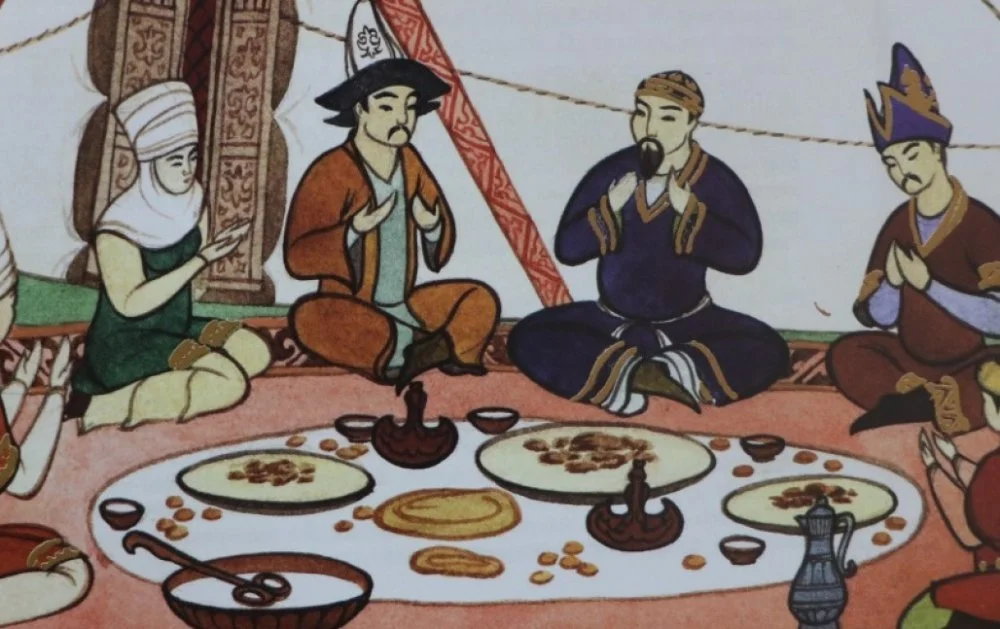
Salvador Dali. The Persistence of memory
Qurt (or kurut) is a food that brings together not only the peoples of Central Asia but also other Turkic peoples, along with the peoples of Mongolia, Iran, and the Caucasus. In Iran, qurt is called kashk, and in Armenia, it's known as chortan.i

Suzma, a clay-like cottage cheese mass, is obtained from qatyk.i
The presence of qurt in such diverse culinary traditions across such a vast territory is fascinating from both a cultural and historical perspective. It reflects the numerous interactions and exchanges that have taken place between different peoples, including Turkic, Arab, Iranian, Armenian, and others.
Historically, nomadic pastoralism was the primary economic activity of Kazakhs, Kyrgyz, Bashkirs, and some Uzbek communities. In the course of their nomadic lifestyle with its frequent migrations, these Turkic peoples developed various 'semi-finished' dairy products that were easy not only to store but also to transport, and fresh milk was not widely consumed because of its perishable nature. Qurt, in essence, is a relative of the oldest cheeses, and is in some ways derived from them. Therefore, when trying to determine when and where qurt began to be made, it is necessary to discuss the appearance of the first cheese.
In different versions, many legends tell us about cheese being discovered by Arab nomads who transported milk in sheep stomachs. Because of the rennet enzymes produced inside the stomachs of ruminant mammals, the milk curdled and the whey separated from the curd, supposedly leading to the discovery of cheese. It is more likely, however, that such cheese discoveries occurred independently in different regions. For example, Central Asian nomads have been transporting mare's or goat's milk in leather bags for centuries, where it ferments quickly due to environmental factors. This accidental process likely led to the discovery of various dairy products, including qatyk.
Archeological and historical evidence indicate that the production of cheese, cottage cheese, and sour milk dates back approximately 10,000 years, coinciding with the domestication of livestock. Archeologists have found traces of whey in different regions and different periods. The oldest evidence of cheese production was discovered in Çatalhöyük, an archeological site in Turkey, where whey was found in a vessel from the western mound (5900–5800 BCE) at the site. Another ancient record of cheese production dates back to 5500 BCE in what is now known as Poland, where sieves with milk fat molecules were found. Ceramic horn-shaped vessels called rhytons, used to store fermented milk products including soft cheese, have been found in the settlements of the Danilo culture on the Mediterranean coast of Croatia, dating back 7,200 years. The process of making cheese is also depicted in ancient Egyptian frescoes.

Kashk / Alamy
Written sources
As for qurt, finding information about the food in written sources is challenging because the names of modern dishes often had different meanings, and their recipes were different in ancient and medieval times. For example, the Iranian word 'kashk', which now refers to dried cottage cheese balls, appears in the ancient Iranian epic 'Shahnameh' or 'The Book of Kings'. However, in this poem, kashk referred to thickened milk and was typically an ingredient in more complex dishes with grains and meat. The word 'qurt' or 'kurut' in its modern sense can be found in the ancient Turkic dictionary written by Mahmud al-Kashgari (1029–1101). Therefore, it can be said that the Turkic peoples were among the first to prepare qurt as we know it today.
Qurt is also linked to the recent history of Kazakhstan. In 1938, the Akmolinsk Camp of Wives of Traitors to the Motherland (ALZhIR) was established in Kazakhstan and held several thousand women in semi-starved conditions. The ALZhIR territory was surrounded by villages, and the local Kazakhs often helped the prisoners by tossing food to them. One of the camp's inmates, Gertrude Platays, who arrived in Kazakhstan in the early 1990s, recounted that local Kazakhs threw qurt through the barbed wire, and the camp guards mistook these balls for stones. These memories served as the basis for a poem titled 'Qurt—Precious Stone' by history teacher Raisa Golubeva. This poem is now preserved in the ALZhIR Museum.

From open access
What to read
1. Yunus Ahmetzyanov // Татарские блюда. — Казань: Татарское книжное издательство, 1969.
2. William Pokhlyobkin Национальные кухни наших народов. — М.: Пищевая промышленность, 1978.
3. Culinary Cultures of the Middle East / ed. Richard Tapper and Sami Zubaida. London, New York, 1994.
4. Alan Davidson, Tom Jaine (ed.). The Oxford Companion to Food (3rd ed.). Oxford, 2014